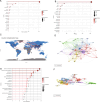Collision of herbal medicine and nanotechnology: a bibliometric analysis of herbal nanoparticles from 2004 to 2023
- PMID: 38556857
- PMCID: PMC10983666
- DOI: 10.1186/s12951-024-02426-3
Collision of herbal medicine and nanotechnology: a bibliometric analysis of herbal nanoparticles from 2004 to 2023
Abstract
Background: Herbal nanoparticles are made from natural herbs/medicinal plants, their extracts, or a combination with other nanoparticle carriers. Compared to traditional herbs, herbal nanoparticles lead to improved bioavailability, enhanced stability, and reduced toxicity. Previous research indicates that herbal medicine nanomaterials are rapidly advancing and making significant progress; however, bibliometric analysis and knowledge mapping for herbal nanoparticles are currently lacking. We performed a bibliometric analysis by retrieving publications related to herbal nanoparticles from the Web of Science Core Collection (WoSCC) database spanning from 2004 to 2023. Data processing was performed using the R package Bibliometrix, VOSviewers, and CiteSpace.
Results: In total, 1876 articles related to herbal nanoparticles were identified, originating from various countries, with China being the primary contributing country. The number of publications in this field increases annually. Beijing University of Chinese Medicine, Shanghai University of Traditional Chinese Medicine, and Saveetha University in India are prominent research institutions in this domain. The Journal "International Journal of Nanomedicine" has the highest number of publications. The number of authors of these publications reached 8234, with Yan Zhao, Yue Zhang, and Huihua Qu being the most prolific authors and Yan Zhao being the most frequently cited author. "Traditional Chinese medicine," "drug delivery," and "green synthesis" are the main research focal points. Themes such as "green synthesis," "curcumin," "wound healing," "drug delivery," and "carbon dots" may represent emerging research areas.
Conclusions: Our study findings assist in identifying the latest research frontiers and hot topics, providing valuable references for scholars investigating the role of nanotechnology in herbal medicine.
Keywords: Bibliometric analysis; Citespace; Herbal medicine; Herbal nanoparticles; Nanoparticles; Traditional Chinese medicine; VOSviewer.
© 2024. The Author(s).
Conflict of interest statement
The authors declare that they have no competing interest.
Figures










References
-
- Wen J, Moloney EB, Canning A, Donohoe E, Ritter T, Wang J, Xiang D, Wu J, Li Y. Synthesized nanoparticles, biomimetic nanoparticles and extracellular vesicles for treatment of autoimmune disease: comparison and prospect. Pharmacol Res. 2021;172:105833. doi: 10.1016/j.phrs.2021.105833. - DOI - PubMed
Publication types
MeSH terms
Substances
Grants and funding
LinkOut - more resources
Full Text Sources

